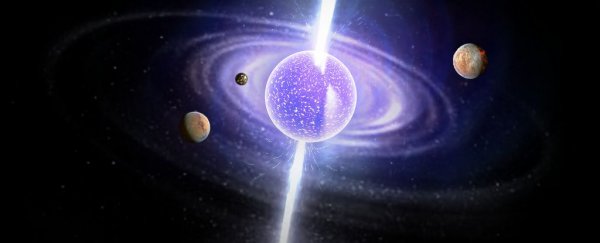In the early 1990s, planetary history was made. In 1992, two astronomers, Alexander Wolszczan and Dale Frail, published a paper in Nature announcing the discovery of the very first planets outside the Solar System.
These two extrasolar planets, or exoplanets, were immediately intriguing. They were rocky worlds 4.3 and 3.9 times the mass of Earth, whirling in orbit around a type of dead star known as a millisecond pulsar, named PSR B1257+12, or Lich for short (Lich is a powerful living-dead creature in folklore). A third exoplanet 0.2 times the mass of Earth was confirmed to be orbiting the pulsar in 1994.
Now an analysis of hundreds of pulsars has revealed that such exoplanets are incredibly rare – almost vanishingly so.
Pulsars are pretty rare; only around 3,320 are known in the Milky Way at time of writing. Of those, astronomers now say, fewer than 0.5 percent are likely to have rocky, Earth-like worlds in orbit. That's just 16 pulsars.
Millisecond pulsars are even rarer, with around 550 known in the Milky Way. That makes humanity's very first exoplanet discoveries pretty freaking amazing.
All dead stars are fascinating, but pulsars add a bit of a kick to the interesting factor.
They're a kind of neutron star; that's the core of a dead star that has reached the end of its atomic fusion lifespan, ejected most of its outer material, and collapsed down into an object whose density is only outstripped by black holes. Neutron stars can be up to around 2.3 times the mass of the Sun, packed into a sphere just 20 kilometers (12 miles) across.
A pulsar is a rotating neutron star that has beams of radiation shooting from its poles. Such is its orientation that, as the pulsar rotates, its beams sweep past Earth, making the star appear to pulse. Think of a really dense cosmic lighthouse.
And because some pulsars have extremely fast rotation – on millisecond scales – those light pulses also occur on millisecond scales. For a better idea of what that means, you can listen to pulsar pulses translated into sound here.
This is a pretty extreme environment. It's possible for them to have exoplanets; since the discovery of Lich and its worlds, a handful of other pulsars have been discovered with exoplanets. However, most of these planets are giants, and those that aren't can get a bit weird, such as an ultradense world thought to be the remains of a white dwarf star cannibalized by the pulsar.
A team of astronomers led by Iuliana Nițu of the University of Manchester in the UK wanted to find out how common pulsar planets are. They conducted a survey of 800 pulsars monitored by the Jodrell Bank Observatory in the UK, looking for blips in the timing of the pulses that might indicate the presence of orbiting exoplanets.
"Pulsars are incredibly interesting and exotic objects," Nițu said.
"Exactly 30 years ago, the first extrasolar planets were discovered around a pulsar, but we are yet to understand how these planets can form and survive in such extreme conditions. Finding out how common these are, and what they look like is a crucial step towards this."
Their search parameters were set to find worlds from 1 percent of the Moon's mass up to 100 times the mass of Earth, with orbital periods between 20 days and 17 years. These search parameters would have detected the larger of Lich's two worlds, Poltergeist and Phobetor, which have orbital periods of 66 and 98 days respectively.
The team found that two-thirds of the pulsars in their sample are extremely unlikely to host exoplanets much heavier than Earth, and fewer than 0.5 percent are likely to host exoplanets in the mass range of Poltergeist and Phobetor.
The presence of exoplanets similar to the smaller exoplanet in the Lich system, Draugr, is a little harder to gauge.
Draugr, with its small mass and 25-day orbit, would not be detectable in 95 percent of the team's sample, since it would get lost in noise. It's unclear how many pulsars would be likely to host such tiny worlds; or even whether it's possible for those worlds to exist outside a multi-planet system.
Of the 800 pulsars, 15 showed periodic signals that could be attributed to exoplanets. However, the team believes that most of them can be attributed to the pulsar's magnetosphere. One pulsar in particular, PSR J2007+3120, looked like a promising candidate for follow-up exoplanet surveys.
That means just 0.5 percent of pulsars are likely to have Earth-like worlds, the team concluded, which means the likelihood of us stumbling across a far distant planet with a rare millisecond pulsar for a star is pretty tiny.
The team also found that pulsar systems are not biased towards any range of exoplanet size or mass. However, any such exoplanets around a pulsar would have extremely elliptical orbits. This is in stark contrast to the nearly circular orbits seen in the Solar System, and suggests that, however they formed, the process was different from the one that produces planets around baby stars just starting their life.
The team's research was presented last week at the National Astronomy Meeting in the UK, and published in the Monthly Notices of the Royal Astronomical Society.
